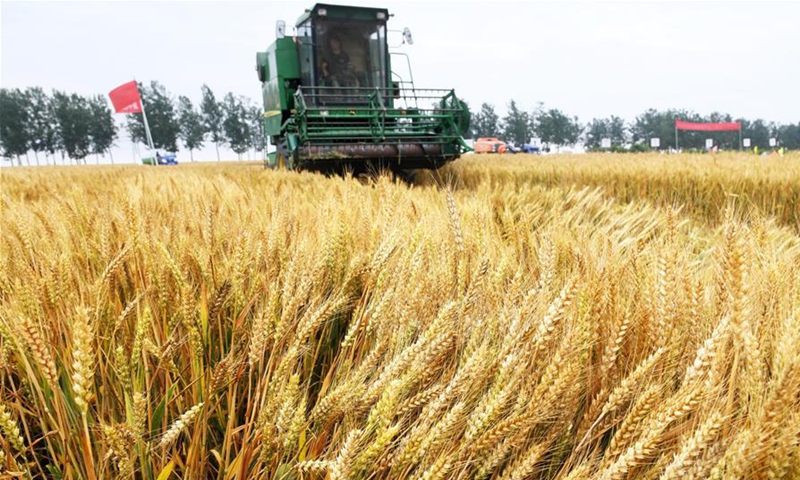E. China province reassesses village-merging project
By Shan Jie Source:Global Times Published: 2020/6/29 20:48:44

An operator drives a reaper to harvest wheat in the field at Tianzhuang Town in Pingdu of Qingdao City, east China's Shandong Province, June 12, 2020. Taking advantage of fair weather, farmers here waste no time to reap wheat with the help from local authorities that streamlined allocation of agricultural machinery. Photo:Xinhua
An attempt to merge neighboring villages into larger communities in East China's Shandong Province has recently triggered debate with some media and academic reports saying many rural residents were reluctant to move. Party secretary of the province has called for a suspension of the most controversial ongoing projects and vowed to respect residents' preferences.Though insiders said the campaign aims to modernize the life in rural areas and could promote local economic and industrial development, the hype of the policy caused a debate in the academic circle, with some experts fearing the move could create difficulty to a few families lacking labor force.
"The projects that are controversial among people and the ones that have not been launched yet should be suspended and checked again," said Liu Jiayi, Secretary of the Communist Party of China Shandong Provincial Committee, who demanded to discuss the village merging campaign during a meeting on Saturday, the local Dazhong Daily reported Sunday.
Liu admitted problems of the campaign and that it was promoted in some places in a "rash" way.
An official in a southwestern Shandong county who participated in the merging village project confirmed with the Global Times on Sunday that the projects he worked on have been suspended. He said the central government has sent inspection groups to investigate in Shandong.
Previously, Li Ganjie, vice Party chief and mayor of Shandong, visited two county-level cities in the province to learn about rural community construction. "The construction should fully respect villagers' will. They should decide if they move or build (new apartments)."
The campaign in Shandong first drew attention as Lü Dewen, a research fellow on rural administration studies in Wuhan University published an article in mid-June, titled "The village merger in Shandong could not be a sample for rural revitalization."
The village merger has also been applied in other parts of China, but usually villagers do not need to leave their old houses, Lü noted in his article.
He Xuefeng, another professor in Wuhan University, said the policy may cause financial strain for some villagers after moving.
Merge for better life
The drive behind the village merger campaign is to tackle the low urbanization rate and help modernize and group together scattered villages to improve the life quality of rural residents, local officials said.
The official the Global Times reached said that previously, local governments had to spend a lot of finances to upgrade facilities such as roads, houses, tap water, toilets and heating. To merge the villages and build new communities could solve such problems "in one step."
According to the project the official was working on, the local township government will move 40,000 villagers into six communities, each containing at least three current villages, within five to eight years.
The new residential buildings built in the communities are expected to include elevators, attics for storage and garages. "Some villagers do not need to pay for the apartments and some would pay about 20,000 yuan," he said.
"The project is supported by the young generations, as most of them now work in cities instead of farming and they prefer modern life," he said, "But the work is still not understood by many and is hard to promote."
"Many people are uncomfortable about houses being torn down," a resident in the county, surnamed Ran, told the Global Times. "Also they want more financial compensation so that they could buy apartments in town. They do not actually want to live in rural communities."
Shandong, with outstanding industry and agriculture, ranked third in GDP within China in 2019. However, its urbanization rate was 61.18 percent, ranking at 11th among all the provincial regions in the country, the China Youth Daily reported in September 2019.
Switch for industry
Behind the merger campaign there is also trading land usage.
Since 2006, upon approval of the then Ministry of Land and Resource, all localities have successively carried out the pilot program of linking new land used for urban construction and the decrease of land used for rural construction.
Under the program, if local governments want land to develop urban construction, such as factories or industries, they have to add the same scale of farming land.
In Shandong's case, as villagers' houses are scattered and occupy large areas of land, tearing down the houses, clustering residents into communities, and restoring farming land would well serve the program of linking the increase and decrease of land use, the official said.
Media reported that local governments could not only increase the efficiency of land use, but also collect funds for poverty relief and rural revitalization through trading the "land quota."
RELATED ARTICLES: